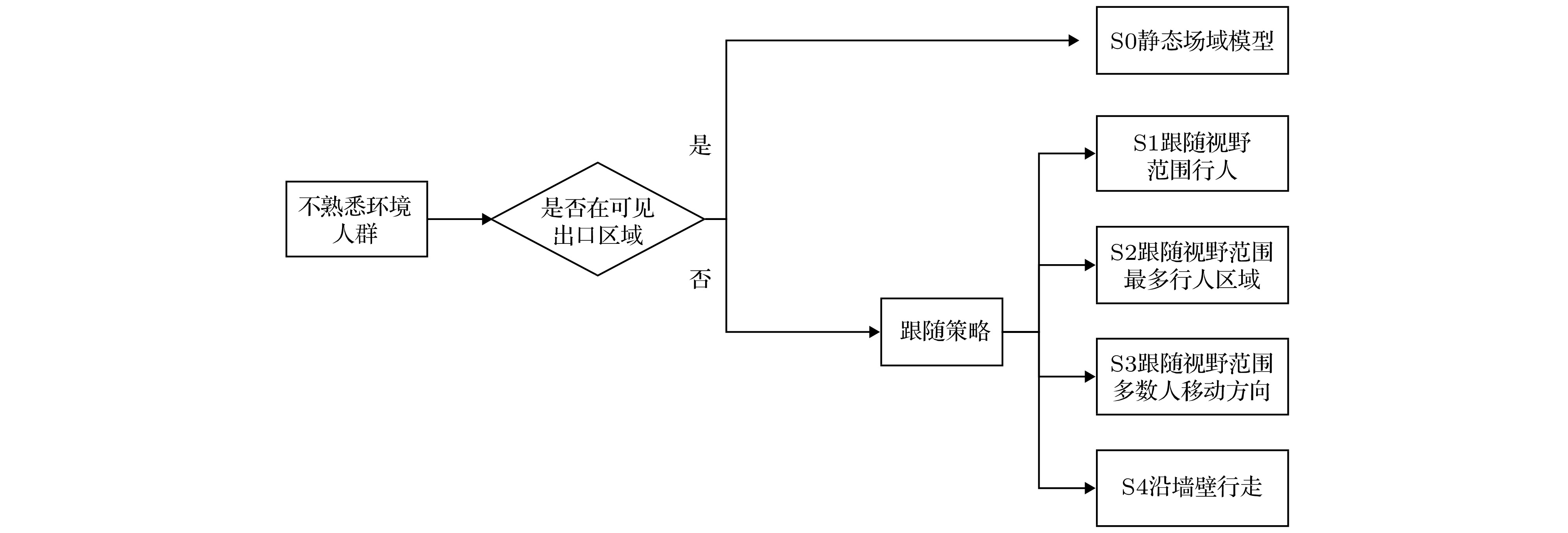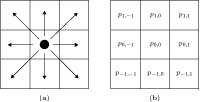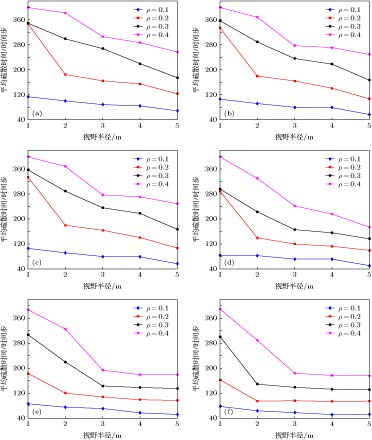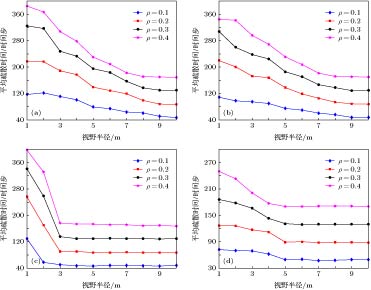-
In order to investigate the following behaviors of pedestrians under limited visibility, pedestrian evacuation is simulated by an improved cellular automata model. Considering the familiarity of pedestrians with the environment, pedestrians are divided into two types: Informed type and uninformed type. For the informed pedestrians, an extended cost potential field cellular automata model is proposed. For the uninformed pedestrians, some following behavior strategies are suggested to study their evacuation behaviors. These following behaviors include following a pedestrian in the visibility (S1), following the most people’s position in the visibility (S2), following the most movement direction in the visibility (S3), and walking along the wall (S4). To investigate the evacuation efficiency of these different following strategies, we compare the performances of different densities of informed pedestrians, different visibility and different pedestrian proportions. As demonstrated by the simulation results, evacuation efficiency and the effectiveness of the following strategies are related to the visibility and density of informed pedestrians. The simulation results show that when the density of informed pedestrians is constant, S4 is more efficient at very poor visibility (R = 1), strategy S3 and S4 are more efficient at poor visibility (1 < R < 7), and the four strategies are equally efficient at good visibility (R > 6). In addition, when the visibility is constant, the density of informed pedestrians is less than 0.5, strategy S3 is the most efficient strategy. When the visibility is constant, the density of informed pedestrians is more than 0.5, the four strategies have a better performance. Moreover, it is noted that the same regular changes also exist in a single strategy environment. These findings can provide some insights into the emergency evacuation of large public places such as supermarkets and stadiums, and help develop effective guidance strategies under limited visibility.
-
Keywords:
- cellular automata /
- visibility /
- familiarity /
- pedestrian evacuation
[1] Helbing D, Molnar P 1995 Phys. Rev. E 51 4282
 Google Scholar
Google Scholar
[2] Helbing D, Farkas I J, Vicsek T 2000 Nature 407 487
 Google Scholar
Google Scholar
[3] Helbing D, Farkas I J, Vicsek T 2000 Phys. Rev. Lett. 84 1240
 Google Scholar
Google Scholar
[4] Helbing D, Isobe M, Nagatani T, Takimoto K 2003 Phys. Rev. E 67 067101
 Google Scholar
Google Scholar
[5] Parisi D, Dorso C 2007 Physica A 385 343
 Google Scholar
Google Scholar
[6] Muramatsu M, Irie T, Nagatani T 1999 Physica A 267 487
 Google Scholar
Google Scholar
[7] Tajima Y, Nagatani T 2001 Physica A 292 545
 Google Scholar
Google Scholar
[8] Nagai R, Fukamachi M, Nagatani T 2006 Physica A 367 449
 Google Scholar
Google Scholar
[9] Blue V J, Adler J L 2001 Transl. Res. B 35 293
 Google Scholar
Google Scholar
[10] Tajima Y, Takimoto K, Nagatani T 2002 Physica A 313 709
 Google Scholar
Google Scholar
[11] Blue V, Embrechts M, Adler J 1997 IEEE International Conference on Systems, Man, and Cybernetics. Computational Cybernetics and Simulation Orlando, USA, October 12−15, 1997 p2320
[12] Burstedde C, Klauck K, Schadschneider A, Zittartzet J 2001 Physica A 295 507
 Google Scholar
Google Scholar
[13] 周金旺, 邝华, 刘慕仁, 孔令江 2009 58 3001
 Google Scholar
Google Scholar
Zhou J W, Kuang H, Liu M R, Kong L J 2009 Acta Phys. Sin. 58 3001
 Google Scholar
Google Scholar
[14] 永贵, 黄海军, 许岩 2013 62 010506
 Google Scholar
Google Scholar
Yong G, Huang H J, Xu Y 2013 Acta Phys. Sin. 62 010506
 Google Scholar
Google Scholar
[15] 岳昊, 邵春福, 姚智胜 2009 58 4523
 Google Scholar
Google Scholar
Yue H, Shao C F, Yao Z S 2009 Acta Phys. Sin. 58 4523
 Google Scholar
Google Scholar
[16] Zhang P, Jian X X, Wong S, Choi K 2012 Phys. Rev. E 85 021119
 Google Scholar
Google Scholar
[17] Jian X X, Wong S, Zhang P, Choi K, Li H, Zhang X 2014 Transl. Res. C 42 200
 Google Scholar
Google Scholar
[18] Hou L, Liu J G, Pan X, Wang B H 2014 Physica A 400 93
 Google Scholar
Google Scholar
[19] Ma Y, Yuen R K K, Lee E W M 2016 Physica A 450 333
 Google Scholar
Google Scholar
[20] Ma Y, Lee E W M, Shi M 2017 Phys. Lett. A 381 1837
 Google Scholar
Google Scholar
[21] Guo R Y, Huang H J, Wong S C 2012 Transl. Res. B 46 669
 Google Scholar
Google Scholar
[22] Frank G A, Dorso C O 2015 Int. J. Mod. Phys. C 26 1550005
 Google Scholar
Google Scholar
[23] Wang P, Cao S 2019 Phys. Lett. A 383 825
 Google Scholar
Google Scholar
[24] Li X, Guo F, Kuang H, Geng Z, Fan Y 2019 Physica A 515 47
 Google Scholar
Google Scholar
[25] Li D, Han B 2015 Saf. Sci. 80 41
 Google Scholar
Google Scholar
[26] Zhang Q 2015 Physica A 419 335
 Google Scholar
Google Scholar
[27] Guo W, Wang X L, Zheng X P 2015 Physica A 432 87
 Google Scholar
Google Scholar
[28] Yuan W, Tan K H 2009 Curr. Appl. Phys. 9 1014
 Google Scholar
Google Scholar
[29] Lu L, Chan C Y, Wang J, Wang W 2017 Trans. Res. C 81 317
 Google Scholar
Google Scholar
[30] Wang X, Zheng X, Cheng Y 2012 Physica A 391 2245
 Google Scholar
Google Scholar
[31] Fang J, El-Tawil S, Aguirre B 2016 Saf. Sci. 83 40
 Google Scholar
Google Scholar
-
表 1 参数说明
Table 1. Parameters description.
变量 名称 名称 物理意义 名称 物理意义 L 房间长度 ρ 行人密度 ${\rm{S1}}, {\rm{S2}}, {\rm{S3}}, {\rm{S4}}$ 行人移动策略 W 出口宽度 Ks 熟悉环境者密度 TS1, TS2, TS3, TS4 策略疏散时间 N 行人总人数 R 行人视野半径 T 行人疏散总时间 -
[1] Helbing D, Molnar P 1995 Phys. Rev. E 51 4282
 Google Scholar
Google Scholar
[2] Helbing D, Farkas I J, Vicsek T 2000 Nature 407 487
 Google Scholar
Google Scholar
[3] Helbing D, Farkas I J, Vicsek T 2000 Phys. Rev. Lett. 84 1240
 Google Scholar
Google Scholar
[4] Helbing D, Isobe M, Nagatani T, Takimoto K 2003 Phys. Rev. E 67 067101
 Google Scholar
Google Scholar
[5] Parisi D, Dorso C 2007 Physica A 385 343
 Google Scholar
Google Scholar
[6] Muramatsu M, Irie T, Nagatani T 1999 Physica A 267 487
 Google Scholar
Google Scholar
[7] Tajima Y, Nagatani T 2001 Physica A 292 545
 Google Scholar
Google Scholar
[8] Nagai R, Fukamachi M, Nagatani T 2006 Physica A 367 449
 Google Scholar
Google Scholar
[9] Blue V J, Adler J L 2001 Transl. Res. B 35 293
 Google Scholar
Google Scholar
[10] Tajima Y, Takimoto K, Nagatani T 2002 Physica A 313 709
 Google Scholar
Google Scholar
[11] Blue V, Embrechts M, Adler J 1997 IEEE International Conference on Systems, Man, and Cybernetics. Computational Cybernetics and Simulation Orlando, USA, October 12−15, 1997 p2320
[12] Burstedde C, Klauck K, Schadschneider A, Zittartzet J 2001 Physica A 295 507
 Google Scholar
Google Scholar
[13] 周金旺, 邝华, 刘慕仁, 孔令江 2009 58 3001
 Google Scholar
Google Scholar
Zhou J W, Kuang H, Liu M R, Kong L J 2009 Acta Phys. Sin. 58 3001
 Google Scholar
Google Scholar
[14] 永贵, 黄海军, 许岩 2013 62 010506
 Google Scholar
Google Scholar
Yong G, Huang H J, Xu Y 2013 Acta Phys. Sin. 62 010506
 Google Scholar
Google Scholar
[15] 岳昊, 邵春福, 姚智胜 2009 58 4523
 Google Scholar
Google Scholar
Yue H, Shao C F, Yao Z S 2009 Acta Phys. Sin. 58 4523
 Google Scholar
Google Scholar
[16] Zhang P, Jian X X, Wong S, Choi K 2012 Phys. Rev. E 85 021119
 Google Scholar
Google Scholar
[17] Jian X X, Wong S, Zhang P, Choi K, Li H, Zhang X 2014 Transl. Res. C 42 200
 Google Scholar
Google Scholar
[18] Hou L, Liu J G, Pan X, Wang B H 2014 Physica A 400 93
 Google Scholar
Google Scholar
[19] Ma Y, Yuen R K K, Lee E W M 2016 Physica A 450 333
 Google Scholar
Google Scholar
[20] Ma Y, Lee E W M, Shi M 2017 Phys. Lett. A 381 1837
 Google Scholar
Google Scholar
[21] Guo R Y, Huang H J, Wong S C 2012 Transl. Res. B 46 669
 Google Scholar
Google Scholar
[22] Frank G A, Dorso C O 2015 Int. J. Mod. Phys. C 26 1550005
 Google Scholar
Google Scholar
[23] Wang P, Cao S 2019 Phys. Lett. A 383 825
 Google Scholar
Google Scholar
[24] Li X, Guo F, Kuang H, Geng Z, Fan Y 2019 Physica A 515 47
 Google Scholar
Google Scholar
[25] Li D, Han B 2015 Saf. Sci. 80 41
 Google Scholar
Google Scholar
[26] Zhang Q 2015 Physica A 419 335
 Google Scholar
Google Scholar
[27] Guo W, Wang X L, Zheng X P 2015 Physica A 432 87
 Google Scholar
Google Scholar
[28] Yuan W, Tan K H 2009 Curr. Appl. Phys. 9 1014
 Google Scholar
Google Scholar
[29] Lu L, Chan C Y, Wang J, Wang W 2017 Trans. Res. C 81 317
 Google Scholar
Google Scholar
[30] Wang X, Zheng X, Cheng Y 2012 Physica A 391 2245
 Google Scholar
Google Scholar
[31] Fang J, El-Tawil S, Aguirre B 2016 Saf. Sci. 83 40
 Google Scholar
Google Scholar
Catalog
Metrics
- Abstract views: 11886
- PDF Downloads: 164
- Cited By: 0














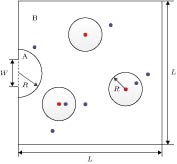
 DownLoad:
DownLoad:

